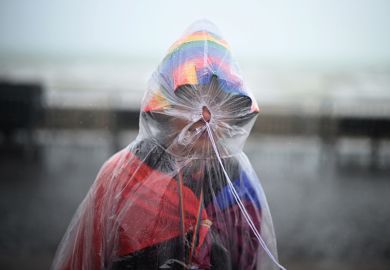In the acknowledgements in The Upswing, Robert Putnam admits that he was spurred to write it when he “stumbled over an unexpected confluence of historical patterns…while tinkering with several obscure data sets”. The result told me a huge amount about the fraying fabric of American life but much less about how to mend democracy.
Never before have I seen such detailed meta-analyses of the changing nature of American society. The “I”-“We”-“I” form of “the arc of the twentieth century”, which Putnam lays out in chart after chart after chart, seems to have an incredibly consistent pattern. The extreme individualism, inequality and conflict at the start reduce across all measures and dimensions up until the mid-1960s, after which the achievements of the progressive era are gradually reversed until we come to the disaffected democracy of today.
That’s not to suggest that the 20th century did not produce elements of constant and positive social progress. Houses did get bigger, child mortality fell, cars proliferated, life expectancy increased, more people finished high school and graduated from college than ever before. But in more recent times these indices mask increases in forms of inequality which reflect structurally embedded factors that too often appear resistant to change. The most striking chart is therefore not about cars or money but the tragic upswing in suicide levels and “deaths of despair” since the millennium.
The central story that Putnam seeks to tell is that the US has faced severe social, economic and political challenges in the past, but it pulled together and charted a different path. A sense of shared responsibility allowed the country to “become demonstrably – indeed measurably – a more ‘we’ society”. Declining economic equality, deteriorating civility and descent into cultural narcissism were halted and reversed in the past, so “we should take inspiration and perhaps instruction from a period of despair much like our own, on the heels of which Americans successfully – and measurably – bent history in a more promising direction”.
The Putnam approach is unashamedly positivist: “what counts” is what can be measured, quantified and presented in charts and graphs. The accompanying narrative struggles at times to convey the real-world relevance of the sweeping lines in terms of deeper tones and texture.
Yet The Upswing left me feeling pretty downbeat not because of its methodological predilections or style but because it left me hanging when it came to the core argument.
This is because of two rather fundamental and interrelated weaknesses. The first is the dominant and explicit assumption that history provides lessons for the future: “In the past America has experienced a storm of unbridled individualism in our culture, our communities, our politics, and our economics, and it produced then, as it has today, a national situation that few Americans found appealing. But we successfully weathered that storm once, and we can do it again.”
This is feel-good political science. But it leaves me feeling bad because it is based on the assumption that there are clear similarities between the challenges of the late 19th century and those that America faces in the early 21st. I’m less convinced that the insights from the past (particularly around “the great convergence” of the mid-20th century) offer as many useful lessons as Putnam seems to suggest.
Just consider the scale of the scientific and technological transformations that have occurred in recent decades, not to mention the explosion in global flows when it comes to knowledge, money and people. The liquid modern here and now – to paraphrase my old friend Zygmunt Bauman – may have little to learn from times that were far more solid and stable. It’s railroads in a time of information superhighways.
The second major weakness of the book is that although it provides an unrivalled account of how America “came together a century ago”, it is far less confident when it comes to explaining “how we can do it again”. The great paradox that it arguably leaves the reader with is the impression that the authors are unsure about how much history really matters. This is reflected in both the structure and content.
The vast bulk of The Upswing is problem-orientated, with a data-driven focus on the up-and-down of its arc through six thematic lenses over almost 300 papers. Through a focus on economics and politics, society and culture, race and gender, it works across a wide landscape, and by the time readers have ploughed through the statistical analyses and historical narrative, they are certainly well versed in the scale and complexity of the challenge. Yet I could not help but feel that the final prescriptive chapter on “Drift and mastery” was incredibly thin, almost porous.
The progressives who raised America out of the trough of the gilded age had, Putnam suggests, two things in common: “a compelling desire to repudiate the downward drift of our nation, and a galvanising belief in the power of ordinary citizens to do so. In their diverse stories – more so than their specific politics, policies or programmes – we may find a blueprint for how to create a similar turning point today.” We may indeed find such a blueprint, but what Putnam identifies is a set of arguably historically specific social trends that occurred in a very different socio-political context from the America of today. Even the sickly sweet subheadings – “From privilege to passion”, “Isolation to association”, “From darkness to light” and so on – do little to veil what often appears as a somewhat quaint and nostalgic view of the power of middle-class benevolence.
The Upswing also claims that early indicators of a powerful civic revival, like that which occurred in the first half of the 20th century, can be identified: “Today we are seeing a similar drive to uncover corruption, expose exploitation, and lay bare the dark underbelly of the ‘I’ society in which we now live.” Yet even with Joe Biden in the White House, I’m struggling to detect this resurgence. It’s hard to see a parallel between the muckraking journalists of the progressive era, who risked their lives and livelihood to root out corruption, and the corrosive 24/7 “attack politics” of today’s journalists. You only have to read the ironic realism expressed in Barack Obama’s first volume of presidential memoirs to see what the media are really doing to American democracy. The book finds cause for optimism, for example, in the student gun-control activism that arose in the aftermath of the 2018 Stoneman Douglas High School shooting in Florida, but is it really possible to identify any major progress in relation to gun control?
Many of the elements that Putnam identifies from history as necessary to move from the dip of the “I” to the peak of the “we” – “a new narrative”, “local innovations bubbling up from below”, “young change-makers”, “a more fruitful national conversation”, “recognising the latent power of collective action” and “a retraining and retooling of average Americans for active citizenship” – are hardly novel. If anything, they are the political equivalent of apple pie, motherhood and clean water.
The Upswing stands out as a sweeping and optimistic interpretation of the trials and tribulations of American democracy. Its management of the data is truly magisterial, as is its interpretation of the 20th century. Yet mending democracy, in the US and beyond, is a messy and complex business for which Putnam provides only half the story. What is urgently required now is a sequel offering a detailed account of how to nurture the changes in civic life that are so clearly needed.
Matthew Flinders is the founding director of the Sir Bernard Crick Centre and professor of politics at the University of Sheffield. He is also vice-president of the UK’s Political Studies Association.
The Upswing: How We Came Together a Century Ago and How We Can Do It Again
By Robert D. Putnam with Shaylyn Romney Garrett
Swift Press, 448pp, £25.00
ISBN 9781800750029
Published 5 November 2020
The author
Robert D. Putnam, Malkin research professor of public policy at Harvard University, was born in Rochester, New York but grew up in a small town in Ohio. He studied at Swarthmore College and won a Fulbright fellowship for the University of Oxford before gaining an MA and a PhD from Yale University and teaching at the University of Michigan.
When his parents “talked about doing things for our kids”, Putnam once recalled, “they meant ‘Let’s pay higher taxes so all the kids in town have a swimming pool at the high school.’ The term our kids meant all the kids in town.” The decline of this kind of civic sense is a central theme of Bowling Alone: The Collapse and Revival of American Community (2000), Our Kids: The American Dream in Crisis (2015) and now The Upswing.
The first of these had its origins in an article, Putnam explained later, that drew out the broader significance of the fact that “although more Americans are bowling than ever – actually, more Americans bowl than vote – bowling in leagues, bowling in teams, is off by about 70 or 80 percent now from the peaks”. When critics suggested that his analysis neglected other forms of social capital, he “spent five years and got really good data on reading groups and soccer clubs and so on, and it turned out…I had underestimated the decline.”
Our Kids, Putnam went on, “start[ed] with the premise, all kids do dumb things…Kids get involved in drinking or, God forbid, they get involved in drugs or they make a dumb romantic decision or they get in a fight with a teacher, or God knows what. When [an upper-class kid] does a dumb thing, instantly airbags inflate to protect the kid from the consequences of the bad decision…If I had a magic wand, I’d give every [poor kid] a caring adult who could provide airbags.”
Matthew Reisz
POSTSCRIPT:
Print headline: The disunited state of America
Register to continue
Why register?
- Registration is free and only takes a moment
- Once registered, you can read 3 articles a month
- Sign up for our newsletter
Subscribe
Or subscribe for unlimited access to:
- Unlimited access to news, views, insights & reviews
- Digital editions
- Digital access to THE’s university and college rankings analysis
Already registered or a current subscriber? Login










